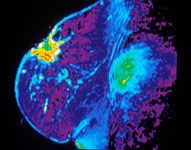Gadobutrol Approved for MRI Evaluation of Breast Cancer
The FDA has approved gadobutrol (Gadavist) injection for intravenous use with breast MRI to detect and identify the extent of disease.
Source: Dr. Steven Harmes. Baylor University Medical Center, Dallas Texas, The Web site of the National Cancer Institute (http://www.cancer.gov).

Color-enhancement show magnetic resonance image (MRI) of individual breast.
Source: Dr. Steven Harmes. Baylor University Medical Center, Dallas Texas, The Web site of the National Cancer Institute (http://www.cancer.gov).
The FDA has approved gadobutrol (Gadavist) injection for intravenous use with breast MRI to detect and identify the extent of disease, according to Bayer HealthCare, the company developing the injection.
The approval is based on the priority review of phase III GEMMA-1 and GEMMA-2 trials, which demonstrated a statistically significant improvement in the detection and identification of extent of disease (80-89% sensitivity) compared with unenhanced MRI (37-73%).
“This is an important diagnostic tool for healthcare professionals with breast cancer patients,” Gillian Newstead, MD, FACR, principal investigator of the GEMMA trials, clinical director, Section of Breast Imaging, University of Chicago Medical Center, said in a statement. “Breast MRI with [gadobutrol] provides important visibility for assessment of malignant breast disease and for treatment planning.”
In total, 787 patients with recently diagnosed breast cancer were enrolled in the identically designed, multicenter GEMMA-1 and GEMMA-2 trials. In each trial, three independent radiologists analyzed and confirmed the efficacy of gadobutrol to improve MRI images of the breast.
Five out of six radiologists confirmed a true-negative rate of greater than 80% for breasts without malignant disease for gadobutrol-enhanced MRI. However, in breasts with malignancy, gadobutrol-enhanced MRI overestimated the histologically confirmed extent of disease in up to 50% of patients.
In each trial, three additional radiologists read x-ray mammography alone. In both trials, sensitivity for the presence and extent of breast malignancy was 68-73% and specificity was 86-94% in non-malignant breasts.
Final data from the GEMMA trials will be presented at an upcoming meeting, according to Bayer HealthCare.
In 2011, gadobutrol was approved by the FDA to detect and visualize areas with disrupted blood brain barrier and/or abnormal vascularity of the central nervous system (CNS) in adults and children over two years old. Gadobutrol is approved in over 60 countries worldwide.
The approval of gadobutrol injection in contrast-enhanced MRI of the CNS was based on the results of two phase III clinical trials. Both phase III trials aimed to compare the efficacy of gadobutrol-enhanced plus unenhanced images with unenhanced images alone. The second phase III study, a crossover study, also looked to confirm noninferiority of combined gadobutrol imaging compared with combined gadoteridol (ProHance) imaging.
In the first phase III study, 1 patient of 343 enrolled experienced a transient ischaemic attack. In the crossover phase III study, of the 399 patients who received gadobutrol first, 1 experienced CNS metastases and another experienced hydrocephalus. One patient who received gadoteridol first experienced somnolence. Other adverse events observed in the phase III trials included headache, nausea, dizziness, diarrhea, and fatigue.